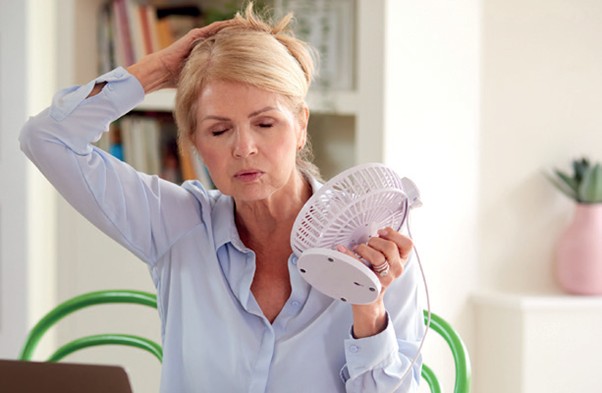For many women, menopause is a word cloaked in mystery, myths, and misinformation.
As a pharmacist, I often meet women in their late 40s to early 50s with questions, concerns, or prescriptions in hand, but not always with clarity about what their bodies are going through.
Let’s clear the fog about menopause – what symptoms are expected and how you can manage this natural phase of life with confidence.

What actually is menopause?
Menopause is defined as the point when a woman hasn’t had a menstrual period for 12 consecutive months. The average age is around 51, though it can happen anytime between 45 and 55.
The transition leading up to menopause – called perimenopause – can begin up to ten years earlier.
During this time, oestrogen and progesterone levels fluctuate and eventually decline, which triggers a host of physical and emotional changes. Symptoms can be mild and manageable or significantly impact quality of life.
What’s normal?
Common experiences include:
- Hot Flushes and Night Sweats
Sudden feelings of heat, often with sweating and a flushed face.
- Irregular Periods
Cycles may become shorter, longer, heavier, or lighter before they stop entirely.
- Mood Changes
Hormonal fluctuations can affect neurotransmitters, leading to emotional ups and downs.
- Vaginal Dryness
Lower oestrogen levels often lead to dryness, itching, or discomfort.
- Sleep Disturbances
Night sweats and shifting hormones can wreak havoc on sleep quality.
- Changes in Libido
Some women notice a dip in sexual desire.
There are 34 symptoms of menopause. Some you may overlook are cold flushes, tingling in the hands and feet, fatigue, vertigo, tinnitus, recurrent UTIs, palpitations, sensitive teeth or painful gums, skin and hair changes, and joint pain.
What’s not normal? When to seek help
While menopause is natural, certain symptoms might signal something more serious:
- Heavy Bleeding or Bleeding After Menopause
During perimenopause, heavy bleeding, periods close together, or lasting longer than a week should be checked. Once periods have stopped for 12 months, any bleeding should be checked. It could indicate a hormonal imbalance, or something more serious like uterine fibroids or cancer.
- Debilitating Mood Changes
If you’re experiencing persistent depression, anxiety, or hopelessness, it’s important to seek help.
- Severe Hot Flushes or Insomnia
If symptoms are significantly disrupting your quality of life, treatment options are available.
- Pelvic Pain, Unusual Discharge, or Odour
These could indicate infections or other gynaecological issues unrelated to menopause and should be assessed promptly.
- Premature Menopause
If your periods stop before you’re 40, and it’s not due to surgically induced menopause (a hysterectomy) or the result of chemotherapy or radiotherapy for cancer treatment, this should be investigated.
HRT: The gold standard but not one-size-fits-all
Hormone replacement therapy (HRT) is considered the most effective treatment for many menopause symptoms. It replaces the oestrogen (and sometimes progesterone) your body stops making during menopause.
There are several types of HRT, the most common being systemic HRT like pills, patches, gels, or sprays that circulate oestrogen throughout the body. These are best for symptoms like hot flushes or insomnia. If you still have a womb, you will also need progesterone to protect its lining.
If you have vaginal dryness, you may benefit from vaginal oestrogen in the form of a pessary, cream or ring which deliver low doses of oestrogen directly where needed.
Who should consider HRT?
Women under 60 and within ten years of menopause onset generally have a favourable risk-benefit profile. For them, HRT can ease symptoms and even offer some protective effects for bone and heart health.
Who might need to avoid it?
Women with a history of certain cancers, blood clots, liver disease or untreated hypertension may need to explore non-hormonal options.
Non-hormonal alternatives
If HRT isn’t for you, or you prefer a more natural approach, there are alternatives such as:
- Lifestyle Adjustments
Cooling techniques (fans, layers, cool bedding) for hot flushes, regular exercise to boost mood, sleep, and bone health, limiting caffeine and alcohol, and mindfulness, yoga, and CBT for stress and emotional balance.
- Prescription Non-Hormonal Treatments
Low-dose antidepressants can reduce hot flushes and mood swings, while gabapentin can also help night sweats and sleep.
- Over-the-Counter and Herbal Remedies
Some women report fewer hot flushes when taking black cohosh, evening primrose oil, red clover, and dong quai. Soy and flaxseed contain phytoestrogens, oestrogen-like plant compounds. However, there isn’t enough evidence about effectiveness.
Always ask your pharmacist before combining supplements with medications. Some herbal remedies interact with common drugs like blood thinners, antidepressants, or birth control.
How a pharmacist can help
Menopause is not a disease, it’s a natural transition. But just because it’s natural doesn’t mean you have to endure it without support.
The key to navigating menopause is understanding your body and advocating for your needs. Whether that means lifestyle changes like yoga and dietary adjustments, or exploring medication and hormone therapy, you have options.
Pharmacists can be a great first point of contact. We can discuss over-the-counter options for symptoms like dryness or insomnia, explain HRT options and side effects, review your current medicines for any interactions, and suggest when to speak with your GP.










